Keys to understanding the pickups
We often get guitars with pickup-related problems. Problems such as that the pickups are out of phase or that they don't cancel the 'hum', the noise that all the single pickups make and that we can make disappear by combining two single pickups. These problems are usually found after trying to make some modification to the guitar, such as changing one or more pickups. If you have ever had such problems, this articlse will help you understand the reasons why and the keys to prevent it from happening again in the future.
PARTS OF A PICKUP
The first thing we have to know is, in a basic way, how a single pickup is built. A single pickup is essentially made up of magnets and a copper coil around them. Finally, the two cables that we find are, simply, the beginning and the end of that coil. At these two ends of the coil, two cables of greater thickness have been soldered and they will be soldered to our circuit.
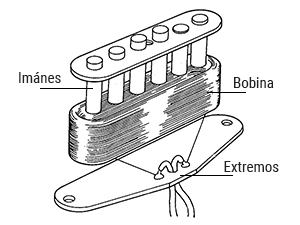 |
Fig. 1. Pickup parts
POLARITY
Once we have understood how a pickup is built, let's talk about its characteristics. First of all, in relation to magnets, we will talk about polarity. We know that a magnet has a north pole and a south pole. Well, the polarity is simply the orientation of the magnets in the pickup. That is, if the north is oriented upwards and the south is downwards or vice versa. To know which pole is at the top of our pickup, that is, which pole is pointed at the guitar strings, we will need a magnet that has the poles marked or, we can also use a compass. Based on the basic principle that two opposite poles attract each other, we can know that, if the north of the compass or the north of our magnet points towards the magnets of the pickup, it will be the opposite pole that faces the strings, that is, , the south pole, in this case.
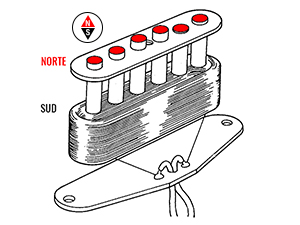 |
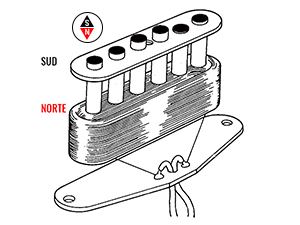 |
Fig. 2. Polarity
PHASE OR THE COIL DIRECTION
The other basic characteristic is what we call phase. The phase is nothing but the direction in which the pickup coil has been wound. That is, whether it has been wound clockwise or counter-clockwise. To determine the direction of our coil, we will have to look at the cables. There will always be a black wire that is the ground (G) and a second wire of another color (usually white, yellow, red ...), which will be the one we call the hot one (H). Well, the direction of the coil always goes from the ground to the hot wire. If the earth is to our right, the coil will be wound clockwise. If the ground is to our left, the coil will be wound in the opposite direction.
|
Fig. 3. Clockwise |
Fig. 4. Counter-clockwise |
Now that we know how a pickup works and can determine its polarity and phase, let's see how these characteristics are related when combining more than one pickup. To understand it, we are going to talk about two more concepts: the cancellation of the 'hum' and what we call 'in phase'. Lets start by the beginning.
QUÉ ES EL 'HUM' Y CÓMO CANCELARLO
El 'hum' es el leve ruido que emiten, con mayor o menor intensidad, todas las pastillas de una única bobina, lo que llamamos pastillas simples. Para eliminarlo, podemos combinar dos pastillas, pero las pastillas tendrán que tener polaridades opuestas. Es decir, si una tiene el norte encarando las cuerdas, la otra tendrá que tener el sur, o viceversa. Si las polaridades son inversas, conseguiremos cancelar el 'hum'. Este es el principio en el que se basan las famosas 'humbucker', que son pastillas con dos bobinas de polaridades opuestas y no emiten este ruido.
|
Fig. 5. Distinta polaridad |
Fig. 6. Misma polaridad |
EN FASE O FUERA DE FASE
Cuando dos pastillas que suenan simultáneamente están fuera de fase, tendremos un resultado muy característico y fácil de reconocer. Podremos reconocer que dos pastillas están fuera de fase ya que tendremos un sonido muy débil, con una carencia anormal de volumen, así como de frecuencias graves y medias. Para conseguir que dos pastillas estén en fase existen dos opciones: o que la polaridad y la dirección de la bobina de ambas pastillas sea idéntica o bien, que sean totalmente opuestas. Si solo una de las dos características es igual o distinta, las pastillas estarán fuera de fase. Por ejemplo, dos pastillas con la misma polaridad y distinta dirección del bobinado, estarán fuera de fase. También estarían fuera de fase, dos pastillas con distinta polaridad y misma dirección del bobinado.
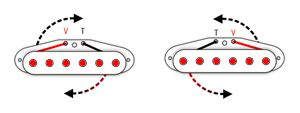 |
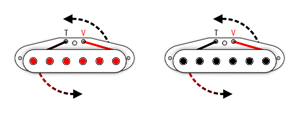 |
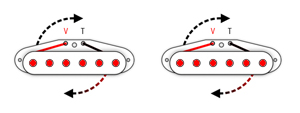 |
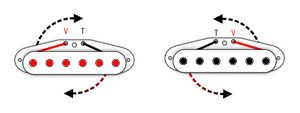 |
En las imágenes anteriores, los dos primeros supuestos son pastillas que tienen una de las características, fase o polaridad, distinta a su pareja. Estos dos primeros ejemplos, estarían fuera de fase. En los dos siguientes, tenemos parejas de pastillas que tienen las dos características idénticas o bien totalmente opuestas. En estos dos casos, las pastillas estarían en fase.
ESCENARIO IDEAL
El escenario ideal, sería conseguir que dos pastillas estén en fase y cancelen el 'hum'. Si hemos visto que para que dos pastillas estén en fase pueden tener características idénticas o totalmente opuestas, pero para cancelar el 'hum' la polaridad ha de ser la contraria entre ellas, podemos deducir que, para tener dos pastillas en fase y cancelando el 'hum', no podremos utilizar dos pastillas de características idénticas, ya que estarían en fase pero no cancelarían el 'hum' al tener polaridades idénticas. Por tanto, únicamente el caso en que tengamos dos pastillas de características totalmente opuestas, nos permitirá tener una combinación de pastillas que estén en fase y que cancelen el 'hum'. Por ejemplo, si una de las pastillas tiene el norte encarando las cuerdas y está bobinada en sentido horario, la otra deberá tener el sur hacia las cuerdas y estar bobinada en sentido contrario a las agujas del reloj. Llegados a este punto, os podemos explicar lo que es el famoso RWRP, que seguro habéis visto en las descripciones de pastillas o de algunas guitarras.
|
Fig.7. Distinta polaridad y distinta fase |
QUÉ SIGNIFICA RWRP
RWRP son las siglas en inglés de 'Reversed Wound, Reversed Polarity'. Esto significa, literalmente, 'bobinado inverso, polaridad inversa' ¡Bingo! Exacto, es justo lo que os acabamos de explicar. Con estas siglas, el fabricante de las pastillas nos está indicando que, esa pastilla en concreto, es de características de polaridad y fase, opuestas al resto. Pero ¡cuidado! Si tienes una pastilla RWRP no es tan sencillo como sustituirla por otra RWRP, porque si cambias de fabricante, quizás lo que un fabricante considera RWRP no es lo mismo que considera otro. Por ejemplo, si un fabricante de pastillas construye pastillas con el norte hacia arriba y el bobinado en sentido horario, sus pastillas RWRP serán justo lo contrario, con el sur hacia arriba y bobinadas en sentido contra-horario. Pero, si otro fabricante las construye con el sur arriba y en sentido horario, sus RWRP serán con el norte arriba y en sentido contra-horario. Así que ambas serían RWRP, según el fabricante, pero cada una tendría características distintas. Así que, lo mejor es utilizar los trucos que os hemos explicado y comprobar directamente qué características tienen las pastillas que tenemos instaladas y pedir al fabricante la pastilla que se ajuste a las características que necesites.
Con todo esto, ya podéis averiguar las características de fase y polaridad de vuestras pastillas y elegir con toda confianza vuestras nuevas pastillas, sin miedo a que entren en conflicto con las que vais dejar instaladas. Si os ha quedado alguna duda, podéis ver el vídeo en el que hablamos más extensamente sobre este tema o bien, podéis como siempre poneros en contacto con nosotros. Esperamos haber despejado algunos de estos misterios que, en realidad, no lo son tanto.
Gracias a todxs y rock'n'roll.

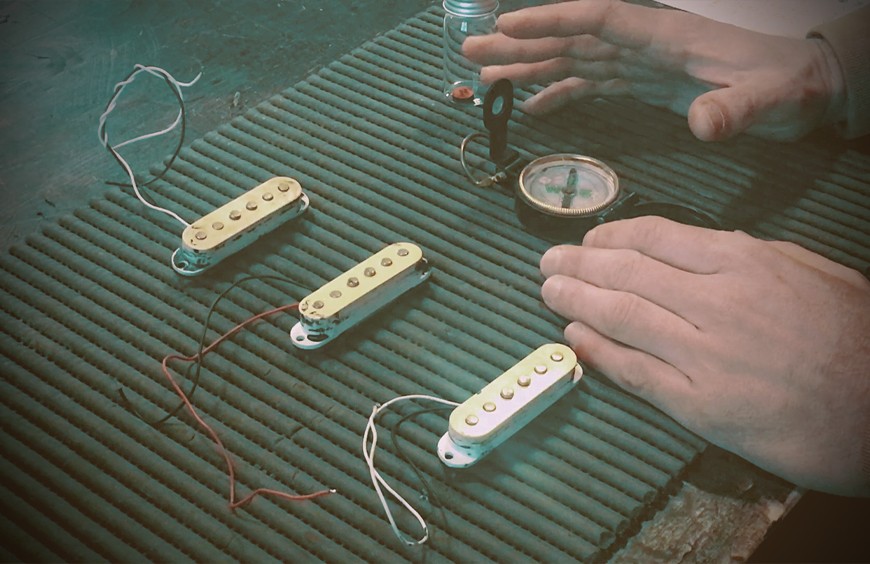
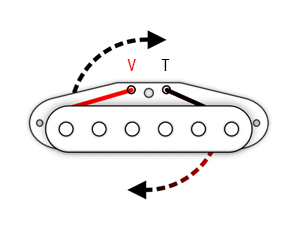
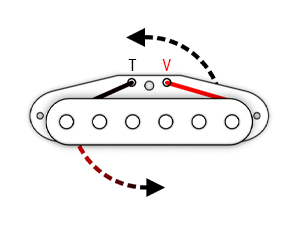
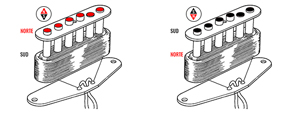
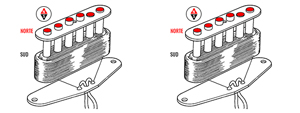
Leave a Reply Cancel Reply